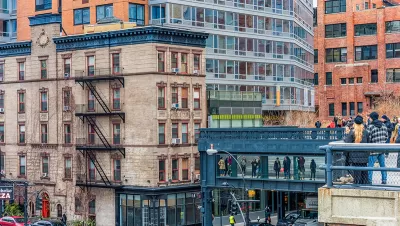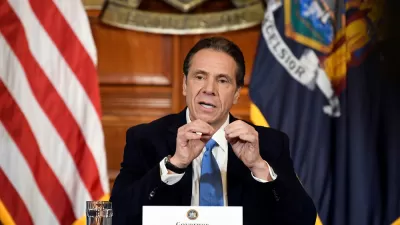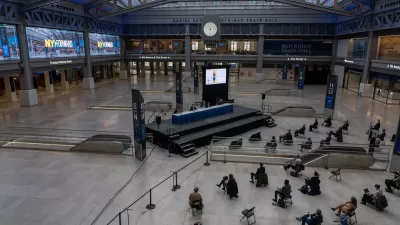The High Line has a chance to add the role of civic connector to its list of plaudits.

Mihir Zaveri and Daniel E. Slotnik report: "Gov. Andrew M. Cuomo said on Sunday that the High Line will be extended to connect to the newly opened Moynihan Train Hall, a project that he said help spur development in the surrounding neighborhoods and boost an economy facing a deep crisis because of the pandemic."
The Moynihan Train Hall opened on January 1, but already these plans promise to connect the newer facility to one of the most recognizable symbols of contemporary New York City.
The proposed link between the High Line and the new train station will create another access point for the station: "A 1,200-foot elevated walkway will connect the existing High Line at 30th Street to a pedestrian path at Manhattan West, a mixed used development adjacent to the train hall," according to the article.
The Moynihan connection isn't the High Line extension plan in the works by the state of New York. " The state is also eyeing another possible expansion of the High Line to connect it north to Pier 76 on West 38th Street, where Mr. Cuomo wants to turn a Police Department tow pound into another park. The existing High Line travels 1.45 miles from 34th Street south to Gansevoort Street in the Meatpacking District," report Zaveri and Slotnik.
The article references questions raised about spending priorities during the pandemic and aftermath. Gov. Cuomo explained how the state will finance the project.
"Mr. Cuomo, acknowledging that the state was facing severe financial difficulties because of the pandemic, said that its portion of the cost would come from infrastructure funds that could not be used to help address budget shortfalls. He said the state was also expecting aid from the federal government for infrastructure projects after Joseph R. Biden Jr. becomes president."
FULL STORY: $60 Million High Line Expansion to Connect Park to Moynihan Train Hall

Study: Maui’s Plan to Convert Vacation Rentals to Long-Term Housing Could Cause Nearly $1 Billion Economic Loss
The plan would reduce visitor accommodation by 25,% resulting in 1,900 jobs lost.

North Texas Transit Leaders Tout Benefits of TOD for Growing Region
At a summit focused on transit-oriented development, policymakers discussed how North Texas’ expanded light rail system can serve as a tool for economic growth.

Why Should We Subsidize Public Transportation?
Many public transit agencies face financial stress due to rising costs, declining fare revenue, and declining subsidies. Transit advocates must provide a strong business case for increasing public transit funding.

How to Make US Trains Faster
Changes to boarding platforms and a switch to electric trains could improve U.S. passenger rail service without the added cost of high-speed rail.

Columbia’s Revitalized ‘Loop’ Is a Hub for Local Entrepreneurs
A focus on small businesses is helping a commercial corridor in Columbia, Missouri thrive.

Invasive Insect Threatens Minnesota’s Ash Forests
The Emerald Ash Borer is a rapidly spreading invasive pest threatening Minnesota’s ash trees, and homeowners are encouraged to plant diverse replacement species, avoid moving ash firewood, and monitor for signs of infestation.
Urban Design for Planners 1: Software Tools
This six-course series explores essential urban design concepts using open source software and equips planners with the tools they need to participate fully in the urban design process.
Planning for Universal Design
Learn the tools for implementing Universal Design in planning regulations.
City of Santa Clarita
Ascent Environmental
Institute for Housing and Urban Development Studies (IHS)
City of Grandview
Harvard GSD Executive Education
Toledo-Lucas County Plan Commissions
Salt Lake City
NYU Wagner Graduate School of Public Service





























